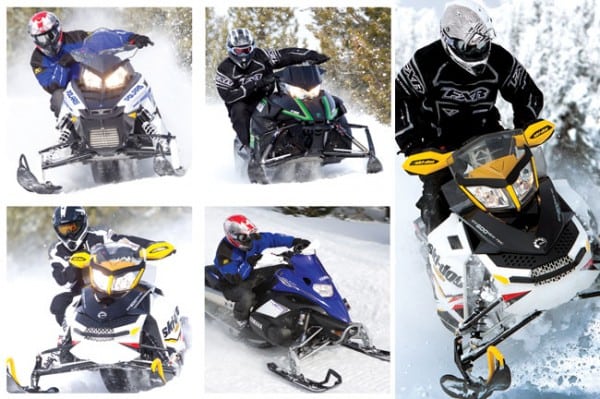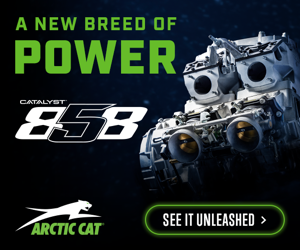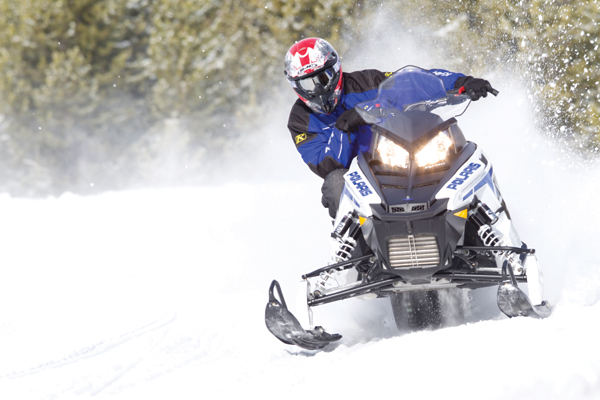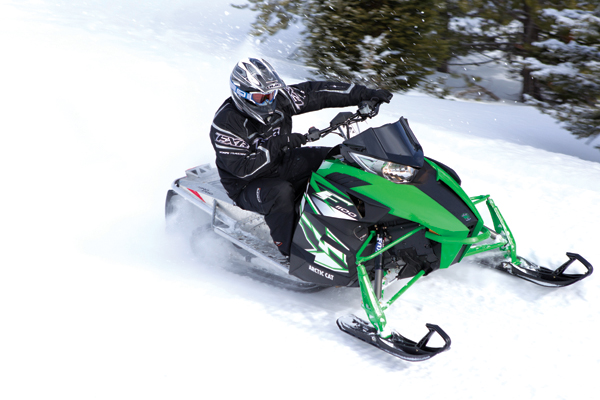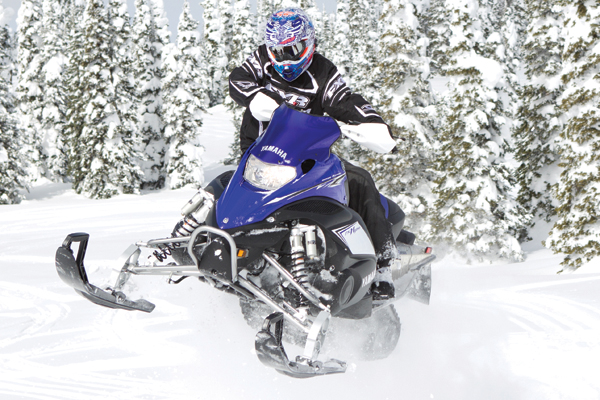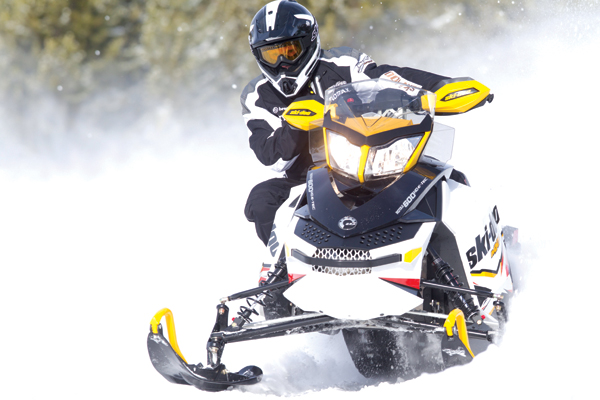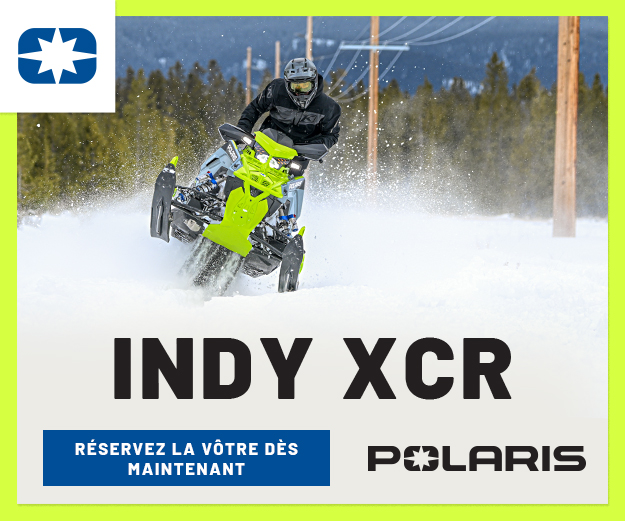While most manufacturer attention of recent model years has aimed at the 800-class, for some people the 600s still offer the right smorgasbord of benefits: Power, economy, price, and handling. The top features are often in place in the following trail performance machines, and each brings something different to the table… buffet style. Are ya hungry?
We know you fast for a while to later splurge for a tasty treat. So gather for the feast – and after our staff of crack nutritional consultants examines the meal each offers, perhaps you will better know what will best satisfy your appetite.
Polaris Rush 600 Pro-R
Some meals have everything it takes to be satisfying: stellar presentation, a great blend of spice and substance, easy to digest and available at a fair price. A fine dining establishment with a great pasta selection usually fits the bill, and Polaris brought its Rush Pro-R 600 to the pasta bar.
The Rush 600 Pro-R is the North Star company’s top performance machine for rough trails, for those that otherwise require active riding because they are full of twists and turns.
There is a great blend of spice and substance to accomplish either type of terrain. Engine power is delectable with the typical Polaris clutching that is dead-on shift efficient; the type appreciated most in corner-to-corner pulls. There is no lag in the driveline and a meaty mid-range is always welcome at our table.
In order to harvest the most thrills and have the greatest performance success with the Rush, drivers need to be aggressive with body position. This holds true for corner leans as well as forward, rearward positioning in the saddle. Polaris has honed its handling along with a ski upgrade on the 2011 unit and there is another change this year with the move to the Race IFS front end.
Polaris claims the new front is served with 20-percent less steering effort, thanks to the new extruded spindles and other race-developed parts. There is a steeper caster and spindle angle that helps to reduce the trail. The other rider-benefit claim is flatter, more precise cornering. We noticed flatter cornering and less effort, but we need more time to determine the increased precision. The test conditions handed to the OSM chefs had revealed a slight steering push on the outside ski – not an uncommon compromise with efforts to reduce the muscle requirements to navigate.
Presentation and spice is enhanced on the Rush Pro-R models coming to showrooms near you, with that wild-looking rear end and suspension supervised by Walker Evans shocks with all the adjustment necessary – and required, by the way. The rear suspension is sensitive to the right spring preload to avoid a bouncy, over-sprung ride or an under-sprung rear that causes excessive weight transfer. It’s easy to adjust, and also easy to influence with body position. It’s just one of the things that make the Rush an entertaining ride. Diners can’t just lope along – they need to be involved when eating up trail miles in curves and bumps.
Some pasta dishes can leave you hungry for more, not long after you leave the table. As far as fair price, while initial purchase price is competitive, the semi-direct injected 600 twin two stroke is the thirstiest sled in this establishment. Driven same trails, same day, same riding style, this engine’s economy differs by 8 miles per gallon or more in our past tests. Without a soon anticipated direct-type fuel management system or significant remapping of the fuel flow, we don’t expect the 2012 600 Rush Pro-R or other shared engine models to be any better.
The Rush Pro R 600 is a delicious entrée. Lots of spice, lots of presentation, and it’s raring to go. The claimed steering improvements need more time to simmer before we can truly pass judgment. And just how some pasta dishes leave you feeling hungry later, the Rush run gets shortened with its hunger at the pump.
Nutritional Information
List Price: $11,699 USA / $12,199 CAN
Weight: 472 pounds / 214 kg
Key Ingredients: 600 Cleanfire engine, Walker Evans shocks, RipSaw track, new Race IFS front end, Indy heritage in its styling.
Arctic Cat F1100 Sno Pro
Arctic Cat’s legacy was lightweight handling. In some cases, it can be argued that some of its pre-Twin Spar machines were under built. Raw, unabashed performance and speed came at the expense of some refinement, but when you rode the black and green, you didn’t have to strip off the matching checkered-flag kitty leather to know you were a speedy sort of guy. About the time the Firecats were due to retire, Ski-Doo was well along the development path with its XP chassis – a whiz right into Arctic Cat’s corn flakes.
A good dose of the bitterness from its northeastern Canadian competitor will fade with the new ProCross chassis; Cat’s return to the lightweight trail performance. The new F-Series machines are the source of the longest lines and most sneeze guard spizzle for model year 2012, as Cat fans spew decadent adoration towards the new chassis.
As far as an entrée, the Thief River Falls, MN fellas grilled up a mean portion of wild game. The Twin Spar effort is infused with lessons from past hunts that in turn, has allowed Cat to score this trophy buck. The foundation of the ProCross is part race sled, part Twin Spar for a combination of lightweight handling and strength, respectively. But there is more to this dish. The venison served here scores a hit with the primal yearning of Arctic’s faithful: raw, lightweight performance.
The Arctic Race Suspension (ARS) front shares components with the same machinery on snocross tracks and cross country courses used during the last several seasons of gold-medal wins. The consumer version has 30-degree bulkhead mount geometry at both upper and lower A-arms for added strength, with Sno Pro models outfitted from the kitchen with Fox Float 2 shocks up front.
There’s more to gnaw on with the ProCross than just suspension and chassis delicacies: the ergos are fantastic too. No more wide-seat cumbrance of Twin Spar. Cat’s new chassis has a sculpted console and seat that begs drivers to transition quickly, without sacrificing all-day rump comfort.
The ability to be active behind the bars is the perfect side dish. Leaning and controlling cornering is a delight – one test driver said the sled handled like it had more trail in the steering than most previous Cats. The steering edge of the ski felt behind the base of the spindle – a quick response, but not quite Ski-Doo precise…yet.
The whole package works well, and we expect production units to be better baked than the prototypes we tested in the late spring. While impressed with initial ride quality and the level of completeness for the launch of an all-new spread of buggies, some difference from sled to sled indicates handling was not fully cooked. Note: we rate handling from great to excellent – our expectations are calibrated high.
While in 2012 Arctic Cat has the 6-banger class represented by its 1100 four-stroke mill, in application since the 2005 model year, the other reason we assign Cat the wild game category is because we believe a new two-stroke 6 is in the crosshairs. We’ll see if it’s another round of kill and grill next season.
Cat officials reported its dealer orders for the F1100 Sno Pro were strong, and with good reason – this chop is lean and delicious. If a future iteration finds a sixxer two-stroke package with less weight under the hood, this venison steak would become bacon wrapped.
Nutritional Information
List price: $10,899 USA / $12,749 CAN
Weight: N/A
Key Ingredients: New ProCross chassis, Arctic Drive system, Slide Action race-developed rear skid w/128-inch track, 1100 4-Stroke Z1 engine, Fox Float 2 shocks
Yamaha FX Nytro RTX
Badged as the trail-calibrated, race replica sled, this machine arrives at mealtime dressed in the corporate blue color as seen on the racetracks in recent years. While the Yamaha factory snocross racing effort reached its refrigerated expiration date, there is no denying the importance the race program played in the development of what’s at dealer locations across the Snowbelt.
So it’s mealtime … and when hungry tummies are comparing a Nytro RTX to a dinner, we think beef pot roast – warm goodness with enough to please all.
Meat and potatoes is what it’s all about – the basic, good stuff is all there to form and meet the requirements of a performance trail sled – the most aggressive in the Yamaha fleet, by the way.
In this class – the cream of the 6-banger crop – the Yamaha is a cheater because it has too much power. If you study the price sheets and have to wonder what the extra cabbage is paying for, it’s the Genesis engine in the belly that turns fuel into more than 135 fun-loving, pleasant sounding horsepower. The sled is as hungry to cover a straightaway distance in a hurry as we are for meat and potatoes when offered a seat at Grandma’s table.
How many times have you been to her table and overeaten? Yeah, us too. Good, well cooked roasts are tough to pass up, and the huge power comes at a tradeoff you are already aware of – the engine is where Yamaha can afford to shed little weight, and it still sits heavy in the belly of this sled where it is revealed at times.
But hidden in the gravy of pot roast, even if you ate too much already, is another bit of goodness. The rear suspension is called the Dual Shock Pro 46 – strange name until you realize that the factory kitchen is calling attention to the massive animal that controls rear arm damping – the C 46 shock that’s adjustable three ways. It’s a selling point for those of you who need to fine-tune the conditions for terrain changes, or for heavier riders who maybe had extra gravy for a few years. At stock settings, there is a nice balance of comfort and ability to eat up the terrain. This is Yamaha’s best skid ever for terrain munching.
And here’s something else to stew on. The ’12 Nytro RTX is a better handling machine too, thanks to the ski and track change. The 8HV ski has a shorter keel than the one it replaces, which helps reduce darting. The exclusive RipSaw II track stores less energy coming into corners, which takes away some of the mid-corner “bizzy-ness” of former models. Remaining imperfections are not hampered thanks to easy mid-corner corrections.
The seat was reworked – the previous one had shortcomings in the form of a seat “memory” that the new version erases. We view the seat as proof of the Nytro’s race program development. The test drivers on the terrain course preferred stand-up riding when calibrating the machine for its terrain appetite. Had they spent more time sitting down, and with bellies more frequently filled with pot roast, the first Nytro RTX would have been closer to being as good as the ’12 version.
Nutritional Information
List Price: $12,199 USA / n/a CAN
Weight: n/a
Key Ingredients: Genesis 135 engine, Camoplast RipSaw II track, Dual Shock Pro 46 rear suspension, Second-gen front end with Fox Float X shocks.
Ski-Doo MX-Z X 600
The Valcourt, Quebec squad carved their buffet section to attract the athletic riders.
Performance nutrition is the dish we’re talking here: high protein, low fat grilled poultry that makes our OSM staff chicken nervous.
Frankly, there is little more to be said that hasn’t already occupied space previously in past issues of OSM, (or even other snow rags for that matter) on the positive attributes and stunning run quality of the 600 E-TEC. If you don’t want to dig up your carefully preserved back issues of OSM and you need the skinny on the 600 E-TEC, then Google it. We haven’t the space to be redundant – but the bottom line is that by default or intent, the E-TEC 6 is the benchmark for its blend of power delivery and economy, by which other trail performance machines are measured.
Ski-Doo has owned lightweight performance since it unveiled its XP creation in 2008, and with it came best-handling awards and accolades. The factory has maintained its advantage with subtle yet effective refinements every subsequent model year.
Among the short list of upgrades is a big suspension impact. Despite shocks calibrated toward connoisseurs of big-bumps, X-package sleds have a super-wide adjustment range that can suit anyone from wispy vegans, to your typical 12 cheeseburger eatin’ big-n-tall shopper. New fer ’12 is a slick skid that widens the range even further – pure culinary delight. The new rMotion skid improves ride comfort and boils three chief benefits to the surface: more travel, more comfort, and easier adjustability. Intrigued?
Polaris claimed a true, progressive, rising rate suspension cannot be accomplished inside the confines of the track – thus the reason for the inside/out Rush suspension. Ski-Doo thinks otherwise, claiming the most rising rate motion ratio along with claims of being the most progressive. This means supple on small bumps with a progressive stroke, without harsh bottoming on the big bumps. More comfort comes from both more travel and the spring rate the long stroke enables, and the easy tuning comes from preload adjustments on all three springs in the system.
OSM cooked the countryside of the sacred testing grounds near West Yellowstone, and struggled to find adequate trail bumps to fully evaluate the added capability of the rMotion. Our test unit had extra spice with the optional Quick Adjust – a bit of a gimmick, but there is no arguing the ease of trailside tuning.
While our performance diet has grilled chicken as its source of protein, we’ll compare the rest of this high-performance nutrition package to an a la carte system. Ski-Doo markets its machines differently: by terrain platform, then optioned with engine, suspension, track and cosmetic variances.
It’s a customizable process that requires some consumer or dealer education for satisfying the hunger. But coming from a factory with a far too many sled models on the menu, the platform and option approach is necessary for spring buyers, albeit frustrating for dealers and in-season buyers. The customized diet has a host of available options –suspension, track, appearance – that can influence the final bill amount, making the menu more difficult to read.
Like our high-performance diet designation, the MX ZX is the most fit, highest performing and best handling machine on this buffet. J
Nutritional Information
List Price (as tested):
$11,699 USA / $13,499 CAN
Weight: 429 pounds / 195 kg
Key Ingredients: XP chassis, new rMotion rear suspension (w/optional Quick Adjust), 600 H.O. E-TEC engine, and the RipSaw track




